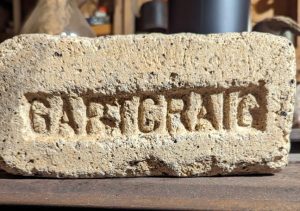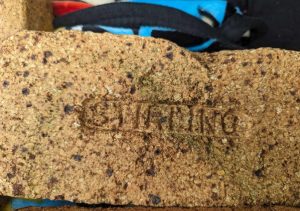(Note – SBH – This page should be read in conjunction with the pages dedicated to the Buccleuch Terracotta Works and the Fauldhead Collieries Brickworks)
Canmore
Info p32 – The Kirkconnel and Sanquhar coal-beds lie in an area measuring nine miles long with a breadth averaging from two to four miles, and is an extension of the Ayr coalfield. The strata descend 1200 feet, and the coal measures lie above the depressed surface of that part of the Silurian area which a fault has lowered. In different seams, with intervening strata, are found “creepie” coals, calmstone, twenty-inch, daugh, splint and swallow-craig coals. In one-half of the field, lying to the southwest, three doleritic dykes, throwing out intrusive sheets, disturb the measures and render the working of coal unprofitable there. In Upper Nithsdale, the Silurian barrier did not sink beneath the sea level until the latter part of the Carboniferous period. At Sanquhar red marls and clays, lying in the upper part of the coal measure, are available for the manufacturing of bricks, terra-cotta, pottery, tiles, etc.
The making of bricks is an industry that has flourished in this district for centuries. Perhaps the earliest notice of it is to be found in the Earl of Queensberry’s letter to his factor relative to certain repairs on the Castle at Sanquhar, which will be found at the end of the third chapter. There seems, however, a reason to believe that bricks of a rough make were in use here even prior to that date (1688). An abundance of clay, excellently adapted for the purposes of brick-making, had always been readily accessible in the lands immediately to the north of the town.
The character of a great portion of the land on that side, from Ryehill for some miles westward is stiff clay; but, in the vicinity of Sanquhar, it is of that particular description of which the hardest and most durable bricks can be made. There are still traces of the ancient brickfields here, where work has been carried on from time to time for generations, and the name ” Bricklands,” which had been given to this part, was doubtless derived from the brick-making industry.
For some time in the first half of this century, no work of the kind was done, but the growing demand for bricks for building purposes, and likewise for draining tiles, in consequence of the extensive introduction, about the year 1850, of the system of draining by tiles, led to the opening in 1852 by Mr Geo. Clennel of a brick and tile work in a part of the field adjoining that previously worked. A large and prosperous trade was done for many years so long as the draining mania lasted, but latterly the trade fell off, partly through the want of capital to adopt the improved machinery that had meanwhile been introduced. Mr Clennel was succeeded in 1889 by another tenant, Mr James Brodie.
1962 – The Upper Nithsdale Coalworks from Pictish Times to 1925. Compiled by J C L McConnel – Brickmaking. This industry formed, in later times, a part of the colliery activities in Sanquhar and Kirkconnel and so is included. In the vicinity of Sanquhar, there are deposits of stiff clay. There are still traces of ancient brickworks in that part known as ‘Brickfields’. The earliest notice of the industry is in a letter dated 31/08/1688 from the Earl of Queensberry to his cousin, Douglas of Dornock. – ‘Cusin, some soon as possible wreat to David Reid … that immediately he meit with Wm. Lukup (William Lukup was master of works in Drumlanrig. His four children were buried in Durisdeer Kirkyard in 1685) and cause him to send some of his men to Sanquhar …’ This was to ‘take in’ the chimneys of the Earls chambers ‘which are by a great deal too large’ and prevent them ‘smoaking’. This work was to be done with the ’tile there … and I’ll not be pleased if I find it not done when I come’. Repairs were also made to the ovens in the kitchen and bakehouse.
In 1840, Adam Anderson, 1809 – 1887, who died in Illinois, USA, second son of the blind colliery manager Christopher Anderson, first discovered the potentialities of clay at Gallowbraes, worked later by Clennell.
Older brickmaking was probably intermittent.
The revival of the industry was caused by the growing demand for building bricks and agricultural draining tiles and bricks for both surface and underground colliery uses.
Mr George Clennell, who came from Durham, where he had been employed by a large brickmaking concern, started a brick and tile works in 1852. He installed an extensive plant. As long as the ’tile draining mania’ lasted, trade was good. The works were near to a previous clay working site. Failing trade and lack of capital, however, ended the venture. The last attempt to work coal near the town was made in 1858 by Mr Clennell near Mathew’s Folly, no doubt in connection with his lease of the brickfield. It had no success. The council claimed against him for abstracting coal from under the road. It was in making this claim that the serious discovery was made that the Burgh Charter was lost. Its replacement in 1864 involved the Burgh in considerable expense. Clennel left Sanquhar in 1889 and died in 1900.
A James Brodie took the works over and extended them. These were known as the ‘top’ works. Later they became the property of Messrs Isherwood Brothers from whom they were purchased by the Sanquhar and Kirkconnel Collieries Limited.
Meanwhile, a lease of the original brickfield, later known as the Buccleuch Works, had been taken over by Mr Matthew McIver from the Duke in 1885. It was over 80 acres in extent, the clay face being 21 feet in height and also a seam of blue clay 4’6″ thick obtained by mining. There was also a mine at the top of the works and the clay face there too was about 30′ in height in the open surface workings.
McIver was the inventor of the steam drying of bricks. He used the exhaust steam from his engines led under the steel floors of tunnels, the bricks from the presses being loaded on bogies and wheeled in the tunnels. When dry, the bricks were taken to the kilns and burned in the usual way. This works too was purchased by the Sanquhar and Kirkconnel Collieries Limited. The site can be seen from the railway near Sanquhar station.
Very high-class facing and engineering bricks were produced as well as nearly 200 other clay products. Some of these were coated with enamel, notably insulators, for electrical work at the collieries.
Facing bricks and other products were exported, some as far as British Columbia, Canada.
An order for bricks from Skye inspired a local poet. The lines were published “Speed bonnie brick, like a bird on the wing over the sea to Skye’
The works were purchased in 1925 as part of the assets of the colliery company by Messrs William Baird and Company. By 1960 both were closed and dismantled.
About 1912, a brickworks was started at the Fauldhead Collieries, Kirkconnel as the increasing demand, both for housing and for colliery purposes, could not be met from Sanquhar. This works utilised clay and shale produced during mining operations and had a high carboniferous content. Once burning had been started, the bricks burned themselves. This type of brick is known as a composition brick, not being a true clay. Every 1000 Sanquhar bricks required from 15cwt to 24cwt of coal to burn them, but composition bricks could be burned by as low as 4cwt per 1000. During the works most active period, machinery capable of producing 40,000 bricks a day was installed.
Below – 04/10/1852 – Dumfries and Galloway Standard – Messrs Dickinson announce that in addition to their Afton Brickworks, New Cumnock they are now opening an extensive brick and tile works at Sanquhar. George Clennel is the manager.

Below – 04/10/1854 – Dumfries and Galloway Standard – Sanquhar Brick and Tile Works, Messrs R Dickinson and Company beg to intimate to proprietors and tenants, and to the public generally, that they have sold and transferred the above works, with the goodwill of the business, to their Manager, Mr George Clennell, and confidently trust, from his long experience and knowledge of the business, that the same success will attend him which they have all along experienced. Mr Clennell will receive and pay all accounts due to and by the Company.
G Clennell with reference to the above, begs to solicit a continuance of the support that has been liberally bestowed upon his predecessors; and has much pleasure in stating that he has recently got material alterations made on, and additions to, the works, including Branch Railway from the Glasgow and South-Western Railway, which will enable him to execute orders with the utmost promptitude, in a superior manner, and at moderate prices. Orders for any place will be received by G. C, the works, and at the following places, by the undermentioned Agents :
Dumfries – William Maxwell.
Thornhill – James Dawson.
Troon – Hugh M’Crorie.
Annan – Henry Pilkington.
Sanquhar, 28th Sept.

Below – 17/09/1856 – Dumfries and Galloway Standard – George Clennell giving away Sarah Pearson at the altar. From the article, he appears to have had the nickname “The Brick”

18/08/1858 – Dumfries and Galloway Standard – Sanquhar Brick and Tile Works. Mr George Clennell, Sanquhar, has appointed Samuel Cavan, Merchant, Kirkcudbright, Agent for the above works in Kirkcudbright, Gatehouse, and neighbourhood. Delivery can be made at any of the shipping ports in the district. Prices and other particulars learnt on application to Cavan. Sanquhar, 12th August 1858.
23/03/1859 – Dumfries and Galloway Standard – Sanquhar Brick and Tile Works – James Derby, coal agent, Auldgirth, begs to intimate to the proprietors and farmers in his District, that Mr Clennell has appointed him agent for the above works at Auldgirth. Prices moderate; and a supply constantly on hand at Auldgirth Station. 17th March 1859.
20/05/1859 – Carlisle Journal – Sanquhar Brick and Tile Works – Richard Wright, Builder, 22 Abbey Street, Carlisle, begs to intimate to the proprietors and farmers of the District that Mr Clennell has appointed him agent for the above works at Carlisle. Samples can be seen, and prices learned, on application to Wright. 19th May 1859.
1867 – George Clennel, Brick and Tile Works Sanquhar.
1867 – Below advert Sanquhar Brick and Tile Works, George Clennell.
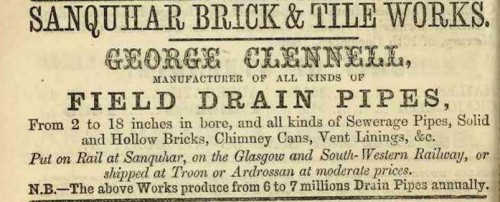
1867 – Joseph Clennel, Brick and Tile Works Manager, Pennyland Cottage, Sanquhar.
Mr James Brodie, who has largely improved and extended the works, which are now in a complete state, and embrace five Newcastle Kilns and a Staffordshire Oven. The improved plant includes a machine for the production of pressed bricks for outside building.
10/02/1873 – Invoice – Sanquhar Fire Brick and Tile Works – G Clennell, fire bricks, flue covers, ground fire clay, gas retorts, flooring tiles, glazed pipes, vent linings, chimney cans, sundials, horse mangers, wall coping, ridge tiles. Manufacturer of manures.
19/11/1875 – Edinburgh Gazette – The Estates of George Clennell, Brick and Tile Manufacturer in Sanquhar, and Soda Water Manufacturer in Glasgow were sequestrated on the 12th day of November 1875, by the Sheriff of Dumfries and Galloway. The first deliverance is dated 12th November 1875. The meeting to elect the Trustee and Commissioners is to be held at two o’clock afternoon, on Friday the 26th day of November 1875, within the King’s Arms Hotel, Dumfries. A composition may be offered at this meeting; and to entitle creditors to the first dividend, their oaths and grounds of debt must be lodged on or before the 12th day of March 1876. A warrant of protection against arrest or imprisonment for civil debt has been granted to the bankrupt, til the meeting of creditors for the election of Trustees. All future advertisements relating to this sequestration will be published in the Edinburgh Gazette alone. Craig and Geddes, Solicitors, Dumfries, Agents
Below – 1886 – Sanquhar Brick and Tile Works, Dumfriesshire. George Clennell.

15/12/1888 – Glasgow Evening Citizen – Action for £2000 damages. The record was closed today in an action raised by George Clennell, brick and tile manufacturer, residing at Crichton Hall, Sanquhar, against Thomas Barker Stewart, mining engineer, Wanlockhead, Abington, and residing at Anchentaggert, near Sanquhar, and William Cron, Raby Villa, there. Pursuer asks the Court to declare that the defenders are bound to concur with him and with Charles Watson, solicitor, Annan, in fulfilling and implementing an agreement entered into by the pursuer and the defenders and the said Charles Watson, having reference to the lease of the brick and tile works, Sanquhar, presently occupied by the pursuer, and to the goodwill, machinery, plant, outbuildings, tramway &c. An alternative claim of £2000 damages is made. The pursuer avers that through the defender’s failure to subscribe and execute the minute he has suffered serious losses, having been led to contract obligations to pay off his debts which he has been unable to implement. The defender says that Stewart’s averments in regard to him are unfounded in fact, Cron says that he never undertook any each agreement.
1889 – James Brodie may have taken over from George Clennel around this time.
22/03/1889 – Annandale Observer and Advertiser – Petition for cessio. George Clennell brick and tile manufacturer, Sanquhar – to be examined in the Sheriff Courthouse, Dumfries 28th March at 11 o’clock. Creditors to meet in the King’s Arms Hotel, Dumfries on Wednesday, March 27 at 11 o’clock. J. Blacklock, agent.
Below – 05/04/1890 – Dumfries & Galloway Courier and Herald – Sheriff Hope has issued his decision in an action in Dumfries Sheriff Court in which Thomas Barker Stewart of Pennyland, farmer, Auchentaggart, Sanquhar sued Charles Watson, solicitor, Annan for £15, the rent of a tramway constructed on the lands of Pennyland, Sanquhar for the conveyance of material to and from the adjacent brickworks to the Glasgow and South Western Railway and which the pursuer let sometime ago to George Clennell, brick and tile manufacturer, Sanquhar who afterwards re-let it to the defender. The pursuer claimed that the defender having acquired the said George Clennell’s right to said tramway or way-leave, and having as tenant, occupier or party in possession used the same for his own purposes and profit is liable to the pursuer in the rent sued for. The defender admitted that an assignation of the lease of the said brickworks was granted by George Clennel to him and explained that the said assignation was granted simply in security of advances made by the defender to the said George Clennell. It was recognised and acted on by all parties simply as a security. The defender pleaded that never having used the tramway for his own purposes and profit and never having been the tenant, occupier or party in possession under the complainer, he was not liable in the rents thereof and ought to be assoilized with expenses … See the article for the full court account.
28/11/1895 – Southern Reporter – Fatal accident at Sanquhar – On Thursday afternoon a young man named Joseph Lindsay, resident at Crawick Mill, was so severely crushed by a fall of clay at the Buccleuch brick and tile works, Sanquhar that he only survived a short time after being removed home.
Below – 1896 – Sanquhar Brickworks to the left and the larger Buccleuch Terracotta Works to the right.
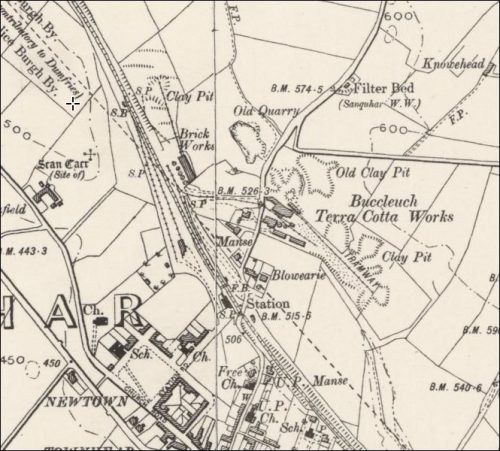
12/09/1896 – Dumfries & Galloway Courier and Herald – We understand that Mr R. Lancaster, who has acted as manager at the Messrs Brodie’s Brick and Tile Works, Sanquhar for some years, has been appointed to a superior post under the Cleghorn Terra Cotta Company Limited, Lanark.
25/12/1896 – Glasgow Herald – James Brodie Limited, Sanquhar Brick and Tile Works, Sanquhar, Dumfriesshire, manufacturers of every description of red and vitrified bricks, moulded and ornamental bricks and string courses, coping for walls and platforms. Paving bricks and tiles suitable for footpaths, railway platforms, coach houses, stables, reservoirs, sewage works &c. Kerbs, channel bricks to work with stable and other bricks. Invert blocks &c. Special bricks made to any particular design if required. All enquiries promptly attended to. Illustrated catalogues sent on application.
03/08/1906 – Northern Daily Telegraph – Brickyard men wanted. (Two or three good, all-round hands). Also machine-man for Fawcett’s machines. Apply Isherwood, Sanquhar. N.B.
Below – 20/05/1908 – Invoice – Sanquhar Brick and Tile Works Co, Isherwood Brothers Ltd. Manufacturers of best read facing bricks, engineering bricks, ornamental and all kinds of special bricks.
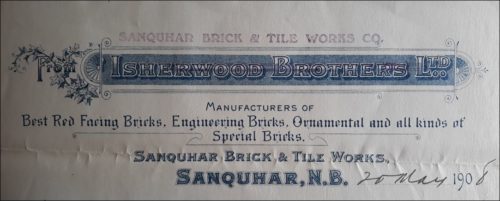
1910 – 1911 and again 1912 – 13 – The Isherwood Bros also made bricks at the Sanquhar Brick and Tile Works.
c. 1912 – 1913 – Sanquhar & Kirkconnel Collieries Limited appear to have taken over the works somewhere around this time frame.
14/03/1912 – Aberdeen Press and Journal – Messrs Cotts Forge, the Buccleuch Terra Cotta Limited and the Sanquhar Brick and Tile Company have all closed their works until the strike is settled.
28/03/1912 – Dundee Courier – Sanquhar men still returning – A further resumption of labour was made yesterday at all three pits belonging to the Sanquhar and Kirkconnel Collieries, Ltd., 143 men returning to work at Gateside Pit, Sanquhar, while 37 miners made a restart at the Fauldhead and Elise Pit, Kirkconnel. Coal is also being drawn at the new mine situated in proximity to the Sanquhar Brick and Tile Works, which is also owned by the Collieries, Ltd. A number of Union men are still working. The total number present work at the local pits represents an increase of fully 30 since Monday. There was no picketing. All the other local industries have now got a copious supply of coal, and are working full time, with the exception of the Nithsdale Hosiery Factory, which is meantime closed. Reports are to hand of a New Cumnock policeman being roughly handled by gang lads.
Below – 13/09/1916 – Dumfries and Galloway Standard – Appeals to the Military Service enlistment.

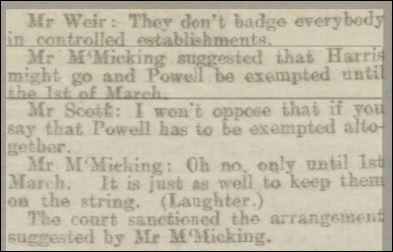
19/12/1917 – Dumfries and Galloway Standard – Accident at Sanquhar Brickworks – Yesterday afternoon, while John Nicholas, who resides with Mrs Caldwell, Castle Street, was engaged shunting waggons in the siding at the mainline, he got his right hand jammed between the buffers of two waggons, with result that part of his thumb and forefinger were smashed. He was attended to by Dr Dunlop and afterwards proceeded home.
Below – 17/04/1918 – Dumfries and Galloway Standard – Appeals to the Military Service enlistment.

19/01/1921 – The Scotsman – Glasgow Housing Committee and brick supply – The Director of Housing reported to the Housing Committee of Glasgow Corporation that he had been in communication with the Sanquhar Brick Company regarding facing bricks, and had arranged to take a supply at a price of 160s per 1000. The Scottish Board of Health, however, had refused to sanction the use of bricks at that price, although the cost of similar bricks obtained through the Department of Building Material Supply, including transport, was higher. The Committee decided to instruct the Director to secure the bricks and to again take up the matter with the board.
Below – 21/01/1921 – Carluke and Lanark Gazette – Architect complaining that the facing bricks for the new houses in Law, Carluke had been increased in price by Sanquhar and Kirkconnel Collieries. (Note – SBH – These were likely made at the Sanquhar Brick and Tile Works or the Buccleuch Terracotta Works)

08/04/1921 – The Scotsman – Harmony in Dumfriesshire – A spirit of harmony prevails in the Sanquhar and Kirkconnel districts. The staff and clerks are managing to keep the mines clear. Other industries are, however, beginning to feel the effects, and a considerable number of men and women have been compelled to cease work at the local brickworks for the lack of fuel. This is regrettable, as there is a great demand for bricks. This stoppage will affect the progress of the local housing scheme.
22/08/1921 – The Scotsman – Sale of steam haulage and road rolling plant by Sanquhar and Kirkconnel Collieries. This was to take place at Sanquhar Brick and Tile Works. (Note – SBH – This equipment seems to be connected with mining activities and the brickworks just appears to be the place where the equipment was displayed for sale) – From a further advert, this sale was due to the completion of timber cutting operations. (Note – SBH – They were still selling equipment under the same circumstances in September 1922 – 19/08/1922 – The Scotsman).

Below – 14/10/1921 – Carluke and Lanark Gazette – Lanark Town Council – Sanquhar bricks versus Belgian imported bricks.
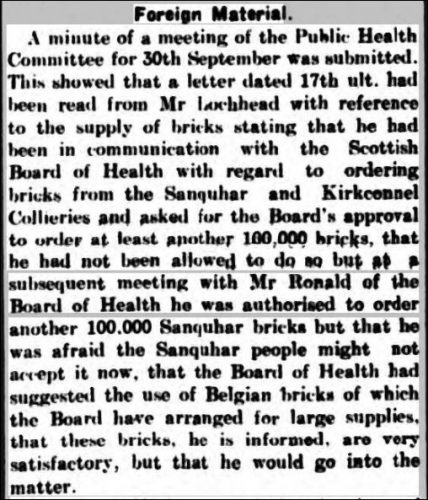
.

1922 – Records of Shirlaw Allan, Industrial auctioneers, Hamilton, Scotland. For sale – Steam and motor lorries at Sanquhar Brick and Tile Works.
Below – 1922 – Sanquhar & Kirkconnel Collieries letterhead – Enquiry dated 13/10/1922 to Wm Forsyth Esq, Town Clerk, Sanquhar for 8 panel paving bricks at 130/- per 1000 and signed J Gordon. Sanquhar & Kirkconnel Collieries owned the Fauldhead Collieries Brickworks and at one point the Sanquhar Brick and Tile Works and the Buccleuch Terracotta Works, Sanquhar.

.

1923 – Sanquhar and Kirkconnel Collieries Company – Chairman and Managing Director of the Sanquhar and Kirkconnel Collieries Ltd., Dumfriesshire – James Irving McConnel. Educated at Charterhouse and Edinburgh University. Served apprenticeship in Mechanical Engineering with the Barrow Shipbuilding Corporation. Entered upon lease of the Sanquhar Coalfield in 1886. County Councillor for Dumfriesshire 1892-1922. J.P. Formerly Captain 3rd V.B. Kings Own Scottish Borderers. Member Royal Company of Archers. (Kings Body Guard for Scotland).
11/02/1924 – The Scotsman – … It is interesting to state that it is exactly 100 years since the grandfather of the chairman of the Sanquhar and Kirkconnel Collieries ( Limited ) procured a lease of the minerals from the Duke of Buccleuch and Queensberry, and without a break, the family have continued to operate on the coal seams and the fireclay utilised in connection with the brick, tile, and terracotta works.
1925 – 1931 – William Baird & Co Ltd ran the Buccleuch Terracotta Works. Source – Brick, Tile and Fireclay Industries in Scotland RCAHMS. (Note – SBH – I would imagine this included the Fauldhead Colliery Brickworks and the Sanquhar Brick and Tile Works).
Below – 15/1927 – The Scotsman – Building erected with Sanquhar bricks for use by older men in Ayr.
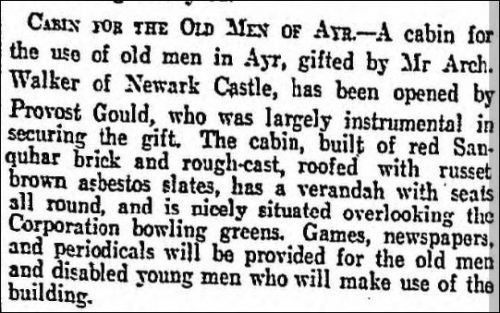
1931 – 1947 – The Baird and Dalmellington Iron Company Limited ran the Buccleuch Terracotta Works. Source – Brick, Tile and Fireclay Industries in Scotland RCAHMS. (Note – SBH – I would imagine this included the Fauldhead Colliery Brickworks and the Sanquhar Brick and Tile Works).
Below – 11/07/1931 – The Scotsman – New Scottish merger – Coal and iron interests. The Dalmellington Iron Company take the Sanquhar and Kirkconnel Collieries from William Baird and Co.
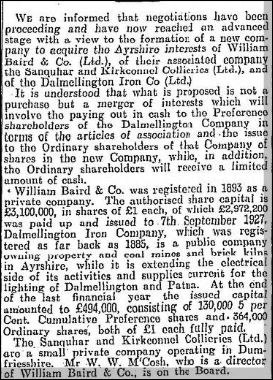
04/01/1939 – Dumfries and Galloway Standard – New cinema for Kirkconnel – Sanquhar and Kirkconnel bricks were used for the erection of the building … (Note SBH – I am uncertain if these were bricks from the Fauldhead Colliery Brickworks or the Sanquhar Brick and Tile Works or the Buccleuch Terracotta Works).
14/01/1939 – Dumfries and Galloway Standard – It was recommended by the General Purposes Committee that for giving air raid warnings two steam-operated sirens be provided at an estimated cost £45 and installed in the corporation gasworks, Lockerbie, and in the brickworks of Bairds & Dalmellington, Ltd., Sanquhar; that a supply of hand rattles and bells be provided for use throughout the county; and that Major W. T. Wilson be appointed chief air warden for the county …
25/09/1940 – Dumfries and Galloway Standard – The employees at Sanquhar Buccleuch Brickworks, owned by Bairds and Dalmellingon Ltd, are presently on short time. Last week they worked the first three days and were idle the last three. A superior class of bricks is manufactured at this works and apparently, the demand for these has slackened off.
14/04/1945 – Dumfries and Galloway Standard – Sanquhar Town Council meeting. The Provost reported that the proposed refuse coup at the top Brickwork was not available because Messrs Bairds & Dalmellington intended to excavate clay from it, but representatives of the company had generously offered another site beyond the low Brickwork, which he, with Treasurer Tweddel and the town clerk had examined, and they considered it very satisfactory in every way. It was well removed from any habitation and would last for several generations. Treasurer Tweddel said that it was an ideal place and might last for 100 years. It was decided to negotiate with the Colliery Company with a view to acquiring this site.
Below – 1950 – 1967 – Sanquhar Brickworks.

1962 – Sanquhar and Kirkconnel Collieries Ltd were wound up.
George Clennell – List of graves in Sanquhar Kirkyard – 534 – in Loving Remembrance of Thomas George Clennell, who died 5th November 1868, aged 11 months. Also of George Edward, who died 20th October 1871, aged 3 months. George Clennell, father of the above, who passed away 23rd December 1900, aged 71 years. George Clennell was a native of the county of Durham. He came to Sanquhar in 1852 as manager of the brickworks erected in that year by Robert Dickenson (Dickinson?) of the Consett Fire Brick Manufactory, Shotley-Bridge, Durham. Ultimately he became the sole proprietor of the works. Associated with Mr George Clennell in the management of the brickworks was his brother, Mr Joseph Clennell, now resident at Rabey Villa, almost a nonagenarian, but still hale and hearty. George Clennell some years before he died sold the brickworks to a Mr Brodie, who carried them on with success for several years; Messrs Isherwood Brothers afterwards owned them, and latterly Mr Scott; now they are the property of the Sanquhar and Kirkconnel Collieries Company. Mr Clennell left Sanquhar in 1889, and for some years was engaged in the wholesale wine trade. He died, as his tombstone states, on the 23rd December 1900, at the age of seventy-one. His wife was Miss Sarah Elizabeth Pearson, Bradford. She died in London in 1908. They had a family of 3 sons and five daughters. (Note – SBH – So who was Mr Scott?).

Below – Unknown date – Sanquhar Brickworks.
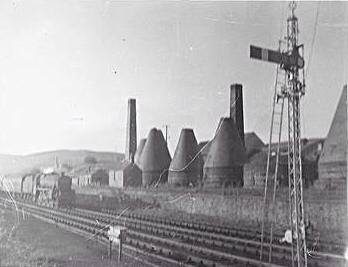
Below – Many thanks to Gladys Cuttle and the Joseph Thomson Group SC029176 for the following information and photographs.
This privvy and adjoining pigsty are located at Penpont, Dumfriesshire. It was built by William George Thomson, father of Joseph Thomson. It is believed that the bricks were manufactured between 1856 and 1860 and the consensus of opinion is they were possibly made at the nearby Sanquhar Brickworks or made on-site by William Thomson. None appear to be stamped but that cannot be confirmed as the structure is still wholly intact. The bricks themselves are slightly thinner than a standard brick and 13″ long with is much longer. The clay used to construct them appears to have been mixed with coal dust and they are lightly fired.

.




























